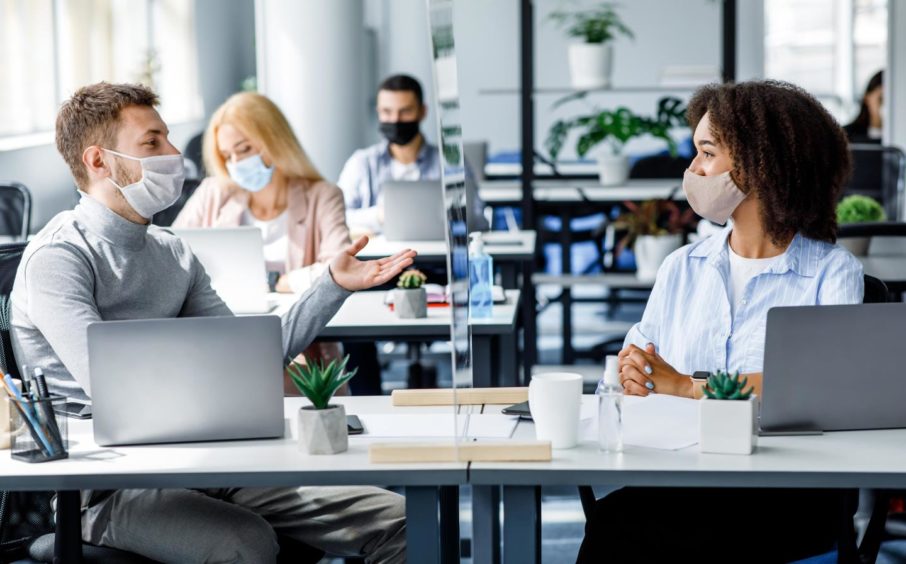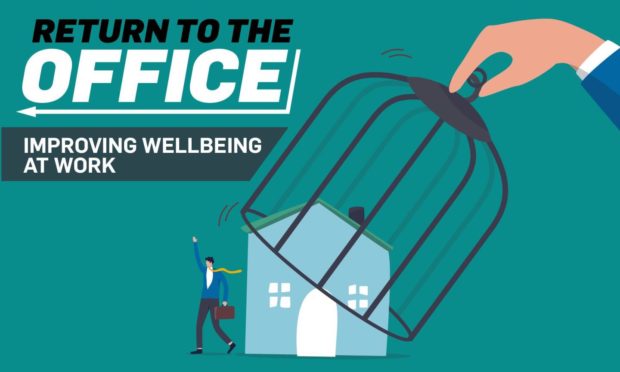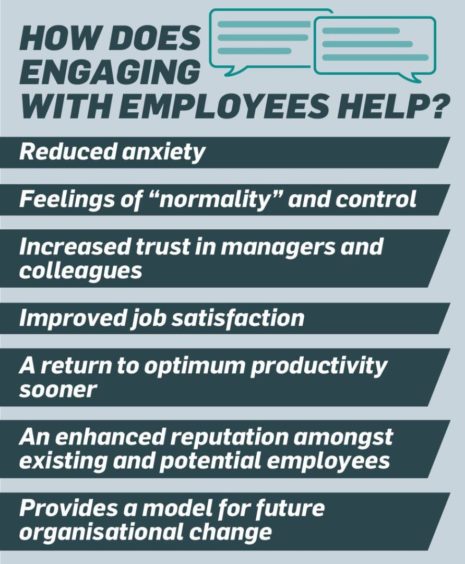The ways of working have forever changed, with hybrid working and home offices popping up since the first lockdown in March 2020.
Continued talks about returning to workspaces have bosses thinking about what the new way of working will look like, and how to ensure their employees’ wellbeing.
After looking at ways staff can manage their return to work worries, organisations also have to think carefully about the support they can offer their employees.
Communication and flexibility are essential
David Jack, a business management lecturer at UHI and HR consultant, said from an organisation’s perspective there are a number of ways they can help ease the transition back into normal places of work.
However, he explained the key elements to getting this right is communication and flexibility—especially on the topic of safety.
“Organisations that are getting this right, quite simply, are the ones that are communicating,” David said.
“They’re speaking with their staff – but also, importantly, listening to their staff. That’s such a big part of this. And organisations that are doing that well, are approaching it in that manner.

“Safety is an important consideration. Some people, more than others, are nervous about returning to the physical workspace if they’ve been away from it for a while.
“It’s important organisations have policies in place, have thought about the procedures.
“There are government guidelines available, of course. With organisations, you’d expect they should be up and running with those, but certainly when you go to demonstrate to staff that they thought about these things that are important.”
Staff must be able to be prepared to communicate specific concerns, of what they would like to happen, and what they think works best for them.
He added: “Thinking about specific concerns, and being prepared to voice them to the manager is really important.”
Demonstrate consideration through practice
To ease staff’s anxieties, organisations should ensure procedures, human resources policy, and health and safety policies are well-thought-out.
David said they should be communicated, reviewed and transparent.
“Thereafter, it’s just that ongoing dialogue and building a culture of where there is a dialogue about these things,” he added.
“It can go a long way to demonstrate that you are taking these things seriously.
“You’ve also got to be prepared as well as a company to make adjustments.
“Again, open to having a flexible approach. There will be people who will have, perhaps disabilities, for example, that are not about to return to the workplace the way other colleagues.
“That flexible mindset is going to be important. And making sure that you demonstrate consideration of these things through your practice, through your policies.”
Companies that might be stuck in “old ways”, or reluctant to think of adapting to new ways of working, could be faced with the consequence where its staff is more likely to leave the organisation.
Staff wellbeing directly linked to performance
Both employers and employees should be approaching the changes with performance in mind.
As a member of staff, David said to think about the change you’re proposing and if you’re still going to be able to perform.
Likewise with managers, who should really think about performance and not “rest on old assumptions” such as having people in the same place in order to monitor them throughout the workday.
According to David, dialogue and being prepared to listen is important to how we’ll find our way in this emerging topic.
“If people feel that they’re listened to, feel like they have a stake in what they do, and they’ve got some involvement in it – that’s all part of the wellbeing pie,” he added.

“There’s a misconception out there that it’s about just healthy eating and yoga, and that might be part of it, but it’s also about the work itself. It’s about how people are managed.
“If people are managed in a way that they feel that they are acknowledged, that they feel that their concerns are looked after, and they feel like safety is taken seriously – then their wellbeing is likely to be higher.
“There’s a misconception out there that it’s about just healthy eating and yoga, and that might be part of it, but it’s also about the work itself. It’s about how people are managed.
“And, I think, more likely. In the real world of management of people, it’s not an exact science, but you can certainly increase your odds of success.”
What is the current government guidance?
According to the Scottish Government website, although many legal Covid-19 restrictions have been lifted under Coronavirus Regulations, employers and employees should continue to manage the risk of transmission of the virus in their workplace.
This means that employers should:
- follow this guidance and any industry guidance that may apply
- continue to conduct and regularly review risk assessments
- continue to work with employees, or employer representative, on health and safety matters. Employers with no worker consultation mechanism can seek advice and assistance from the STUC and Scottish Hazards
- help employees to understand the steps they can take to prevent Covid-19 spreading in the workplace

A gradual return to offices can begin in line with staff wellbeing discussions and business need, however, home working continues to be important mitigation for controlling the virus.
Businesses are being asked to still support employees to do this, where possible and in consultation with employees.
Employers are urged to consider, for the longer term, a hybrid model of home and office working – which may, of course, have benefits beyond the need to control a virus.

